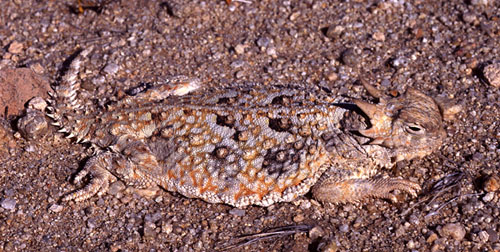Desert Horned Lizard (Phrynosoma platyrhinos) - Wiki Desert horned lizard
From Wikipedia, the free encyclopedia
[Photo] Phrynosoma platyrhinos - Desert horned lizard. Source: USGS, http://www.werc.usgs.gov/fieldguide/phpl.htm Photo by Chris Brown
The Desert horned lizard (Phrynosoma platyrhinos) is a horned lizard native to western North America. They typically range in size from 3 - 5in (7.6 - 13.6cm). They are sometimes referred to as "Horned Toads" or "Horny Toads", although they are not toads.
This species of lizard has a distinctive flat-body with one row of fringed scales down the sides. They have one row of slightly enlarged scales on each side of the throat. Colors can be variable and generally blend in with the color of the surrounding soil, but they usually have a beige, tan or reddish dorsum with contrasting, wavy blotches of darker color. They have two dark blotches on the neck that are very prominent and are bordered posteriorly by a light white or gray color. They also have pointed scales on the dorsum (back) of the body. Juveniles are similar to adults, but have shorter and less-pronounced cranial spines. Desert Horned Lizards have horns that are longer than they are wide at the base, which isn't true for their congener, the Short-horned lizard.
Desert horned lizards prey primarily on ants, but are also known to prey on other slow-moving insects such as beetles, as well as spiders and some plant material. They can often be found in the vicinity of ant hills, where they sit and wait for ants to pass by. When they find an area of soft sand, they usually shake themselves vigorously, throwing sand over their backs and leaving only their head exposed. This allows them to hide from predators and await their unsuspecting prey.
They can usually be found in arid regions that have at least some loose soil available for burrowing, usually areas with sandy soils and limited vegetation such as sagebrush or shadscale. Still, they can also be found in areas with hardpan and gravelly soils as well. They typically range from southern Idaho in the north to northern Mexico in the south.
These lizards mate in the spring and lay 2-16 eggs in June to July, which hatch sometime in August. Incubation lasts about 50-60 days. Individuals reach maturity in about 22 mo.
They are generally a gentle species, but have been known to try to push their crainial spines into the hand while held. If provoked, they hiss and threaten to bite. When excited, they puff themselves up with air, similar to the way a Chuckwalla does, making themselves look bigger. If spotted near a bush, they will dash into it in an attempt to find cover from any threat. If threatened, they have been known to squirt blood from their eyes as far as 5 feet.
There are considered to be two subspecies: the Northern Desert horned lizard, Phrynosoma platyrhinos platyrhinos, ranging in Idaho, Utah, and Nevada and parts of southeastern Oregon; and the Southern Desert horned lizard, Phrynosoma platyrhinos calidiarum, ranging in southern Utah and Nevada to southeast California, western Arizona and northern Baja California.
http://en.wikipedia.org/wiki/Desert_horned_lizard
| The text in this page is based on the copyrighted Wikipedia article shown in above URL. It is used under the GNU Free Documentation License. You may redistribute it, verbatim or modified, providing that you comply with the terms of the GFDL. |
